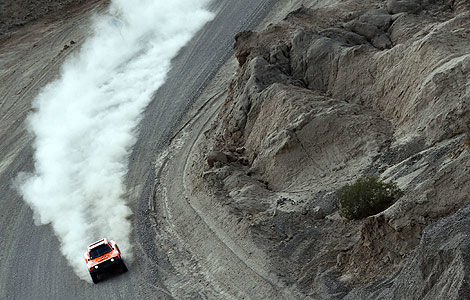History etched in stone
Updated: 2014-01-12 11:19
By Mike Peters (China Daily)
|
|||||||||||
 |
|
Ruskamp and his wife Linda climb in New Mexico. Photo Provided to China Daily |
While many academic experts have been skeptical, one of the leading Western experts in Chinese script has supported Ruskamp's work.
"You have a Shang ancestor up there, the third Shang king," Ruskamp recalls being told by David N. Keightley, professor emeritus at the University of California at Berkeley and well-known scholar of ancient Chinese script.
"So this is no longer a chance doodle by somebody walking through," Ruskamp recently told experts at Paths Across the Pacific VIII, a conference on cross-continented migration held in Sitka, Alaska. Ruskamp used the event to roll-out the research findings in his just-published second edition of Asiatic Echoes: The Identification of Ancient Chinese Pictograms in Pre-Columbian North American Rock Writing.
"The mostly PhD-level scientific audience overwhelmingly embraced my presentation as conclusive proof for the presence of pre-Columbian Asiatic entry into the Americas, likely around 900-500 BC," he says.
But while Keightley reviewed Ruskamp's book positively and made supportive annotations on the photos, other experts in both the West and China find the dates involved hard to accept.
Ruskamp understands.
"This has not been an easy study to carry out," he says. "Knowledge of both the form of ancient Chinese scripts, Native American folklore and the styles of native rock art are required."
Ruskamp says that if skeptics doubt that Chinese brought their culture to the Americas at least five centuries before Christ, they must believe that the same written language evolved independently, just by chance. The oracle-bone script, carved on turtle shells by the scribes of the Zhou Dynasty (c.11th century-256 BC) was extinct for hundreds of years - only rediscovered in 1899.
"For these things to be phony, they would have to have been created in the past 120 years," he says. His book describes how independent testing of the rock art and its weathering have proved that the carved images are much older.
The narrow historical period of that long-dead writing allows modern scientists to "nail down the date - something that normally in rock art we can't do", he says. "Many examples seem to be classic oracle-bone divination.
"I've published 53 different examples, from the US Southwest to Canada. It's an open script - people across the continent knew what it meant."
But such research, he notes, is a highly speculative endeavor with admittedly a very low probability of success.
"I wouldn't be doing it unless it was enjoyable in its own right," he says with a laugh.
Related Stories
Exploring the history and culture of China 2013-12-30 09:09
Exploring history with 3D paintings 2013-12-26 15:46
Tracking the Peninsula's rich history and tradition 2013-12-21 07:58
Hotpot museum gives Chongqing a taste of history 2013-12-13 17:06
Museum preserves hutong history 2013-12-12 09:41
Today's Top News
Former Israeli PM Ariel Sharon dead at 85
Fire in China's Shangri-la put out
Overseas investment leads growth
Hainan fishing zone rule 'nothing new'
UK health team to take pulse of China business
Japan must show respect: France
Top scientists awarded $826,000
Apology urged for insulting Chinese
Hot Topics
Lunar probe , China growth forecasts, Emission rules get tougher, China seen through 'colored lens', International board,
Editor's Picks

|

|

|

|

|

|





